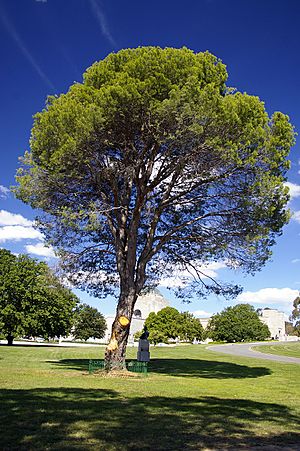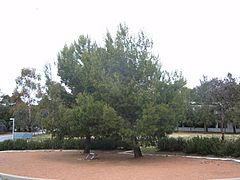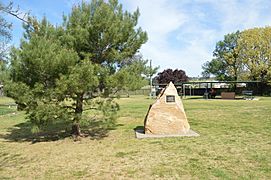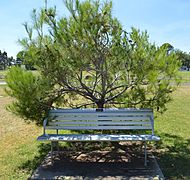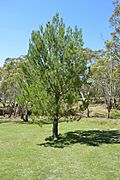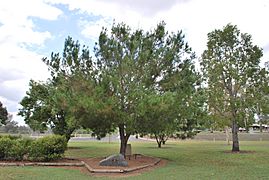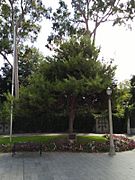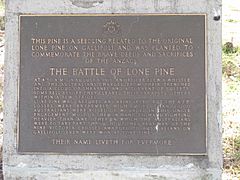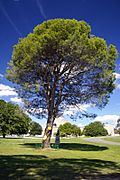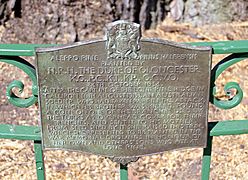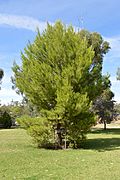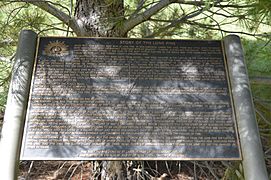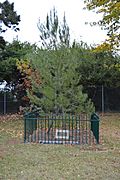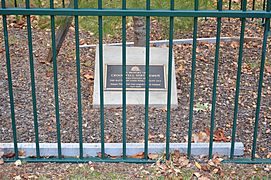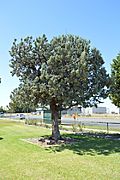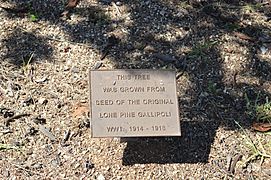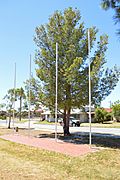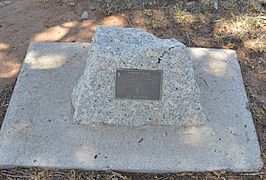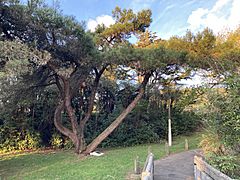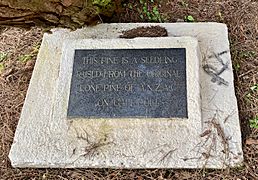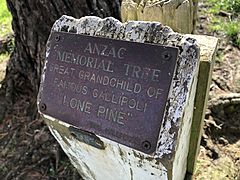Lone Pine (tree) facts for kids
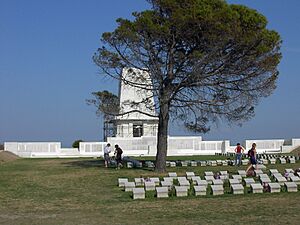
The Lone Pine was a single tree on the Gallipoli Peninsula in Turkey. It marked the spot of a very important battle called the Battle of Lone Pine in 1915. The original tree was a Turkish pine (Pinus brutia).
Today, many pine trees are called "Lone Pines" or "Gallipoli Pines." These trees are planted to remember the brave Australian and New Zealand soldiers who fought at Gallipoli. There were actually different types of pine trees in the area. Besides the Turkish pine, the Aleppo Pine (Pinus halepensis) was also common. Turkish soldiers used branches from these trees to build their trenches.
The tree that stands at the Lone Pine Cemetery in Gallipoli today is a different kind of pine. It is a stone or umbrella pine (Pinus pinea).
Contents
The Original Lone Pine Tree
The "original" Lone Pine was a Turkish pine (Pinus brutia). It was the only tree left from a group that Turkish soldiers had cut down. They used the wood and branches to cover their trenches during the battle. Other trees, especially Aleppo pines (Pinus halepensis), were also cut down.
The original Lone Pine tree was destroyed during the battle. However, some pine cones stayed attached to the cut branches over the trenches. Different Australian soldiers found these cones and brought them back home to Australia. Seeds from one soldier's cone grew into Turkish pines. Seeds from another pair of soldiers' cones grew into Aleppo pines.
A Memorial Tree in Gallipoli
At the Lone Pine Cemetery on the Gallipoli peninsula, a single pine tree was planted in the 1920s. This tree was meant to represent the original Lone Pine. In 1987, an Australian plant expert checked this tree. He confirmed it was a stone pine (Pinus pinea).
Lone Pine Trees in Australia
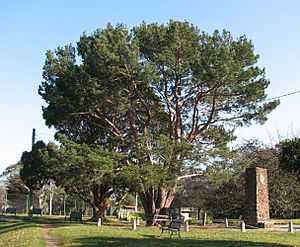
How the Seeds Came to Australia
Keith McDowell was an Australian soldier from the 23rd Battalion. He fought at Gallipoli and brought a pine cone home to Australia. Many years later, his wife's aunt, Emma Gray, planted seeds from the cone. This happened in Grassmere, near Warrnambool, Victoria. Five seedlings grew, and four of them survived.
These four young trees were planted in different places in Victoria:
- Wattle Park, Melbourne (May 8, 1933)
- The Shrine of Remembrance (June 11, 1933)
- The Soldiers Memorial Hall at The Sisters near Terang (June 18, 1933)
- Warrnambool Botanic Gardens (January 23, 1934)
Another soldier, Lance Corporal Benjamin Smith from the 3rd Battalion, also found a cone. He sent it to his mother, Mrs. McMullen, in Australia. She had lost another son in the battle. In 1928, she planted seeds from the cone, and two seedlings grew. One was given to her hometown of Inverell, New South Wales. The other was sent to Canberra. Prince Henry, Duke of Gloucester planted it at the Australian War Memorial (AWM) in October 1934.
Important Lone Pines in Australia
The tree at the Shrine of Remembrance in Melbourne was planted by Lieutenant-General Sir Stanley Savige. He was the founder of Melbourne Legacy. In 2005, a large branch broke off, and the tree needed support. In 2012, the tree had to be removed because of a disease caused by a fungus. A "grandchild tree" was planted nearby in 2006.
The AWM Lone Pine tree in Canberra lost two big lower branches in a storm in 2008. But tree doctors were able to save this important tree.
Both Melbourne Legacy and the Yarralumla Nursery in Canberra have grown many seedlings. These come from the trees at the Shrine of Remembrance and the Australian War Memorial. They give these young trees to schools, veteran groups, and other organizations across Australia.
Other "Lone Pines" in Australia include:
- A pine tree at the entrance to Oatley Park, NSW. A plaque says it was planted in 1920 from cones from Gallipoli.
- Two Lone Pine seedlings at the Australian Defence Force Academy in Canberra. The RSL gave them on Remembrance Day, November 11, 1987.
- The pine at Adelaide's National War Memorial. A plaque says it is a seedling from the original Lone Pine.
- A seedling of Pinus brutia was planted at the Victorian School of Forestry at Creswick on March 23, 1975.
-
Lone pine tree at
Oatley Park, NSW -
Pinus brutia -
Coolah, NSW -
Pinus halepensis -
Cootamundra, NSW -
Pinus halepensis -
Mundubbera, Qld -
Pinus halepensis -
Adelaide's memorial -
Pinus halepensis -
Australian War Memorial
Pinus halepensis -
Balranald, NSW -
Pinus halepensis -
Crookwell, NSW -
Pinus halepensis -
Finley, NSW
Lone Pine Trees in New Zealand
In Auckland, New Zealand, two trees are known as "Lone Pines." One is a Pinus canariensis planted at Waikumete cemetery in 1961. The other is a Pinus radiata at Auckland War Memorial Museum. Victoria Cross winner Cyril Bassett planted it on Anzac Day in 1950.
A tree called "The Anzac Pine" stands on Te Mata Peak in Havelock North. The first tree planted there was a Pinus brutia, but the current tree is a Pinus radiata. Two Pinus halepensis trees were planted in 1951 at the Lone Pine Memorial in Taradale cemetery. More trees are in King Edward Park in Stratford and Queens Park in Whanganui.
There is also a "Lone Pine" at the Paeroa golf course. This tree seems to be New Zealand's only true Pinus brutia that can be traced back to the original pines. This information comes from a forestry journal. In Dixon Park, Greymouth, and Victoria Park, Christchurch, plaques say that nearby pine trees grew from seedlings of the Gallipoli Lone Pine.
-
Dixon Park, Greymouth
Images for kids


